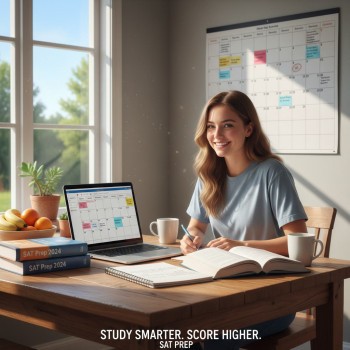Why tracking SAT prep across multiple devices feels harder than it should
Most students today don’t study for the SAT on a single machine. You preview vocabulary on your phone while riding the bus, complete a practice section on a laptop at the library, and review math flashcards on a tablet before bed. That flexibility is amazing — until you can’t remember which device has the latest notes, which practice test you finished, or where you saved that one explanation that finally made inferences click.
This post is for the multitaskers and the mobile learners: a friendly, practical guide to keeping your SAT prep tidy, synced, and stress-free across devices. You’ll find strategies for file organization, note-taking, practice tracking, scheduling, offline planning, and security. There are examples, a sample weekly plan, and even a short, copyable template you can adapt. If you ever decide you want personalized help, Sparkl’s personalized tutoring — with 1-on-1 guidance, tailored study plans, expert tutors, and AI-driven insights — can slot into these routines naturally and efficiently.
Start with a small map: decide what matters to track
Before you choose apps and sync strategies, decide what you actually want to keep consistent across devices. Narrowing your focus prevents overcomplicating everything.
- Practice test progress (which tests, scores, and dates)
- Targeted lesson plans (what you’ll study week-to-week)
- Notes and solutions (especially worked math examples and reading annotations)
- Flashcards and vocabulary lists
- Timed-section logs and pace data
- Motivation and reflection (how you felt, what worked)
Treat this list like a short checklist. If a tool or routine can’t easily track one of these areas, it’s probably not worth the friction.
Choose a central hub: where will your truth live?
Pick one place to be your ‘single source of truth’ — the canonical location where you update your study status. Everything else should sync to or reference that hub. Common hubs include a cloud notebook (like a notes app), a file-sync folder, or a scheduling/calendar tool. The goal is clarity: when in doubt, go to your hub.
Hub options and when to use them
- Cloud notes (e.g., a cross-device notes app): best for quick edits, annotated reading passages, and short math solutions.
- Cloud storage folder (documents/PDFs): best for practice tests, marked-up PDFs, and exported work.
- Study planner app or calendar: best for schedule adherence, reminders, and blocking study time.
- Dedicated SAT platform dashboard (if you use one): best when it tracks tests and provides tailored next steps; you can pair this with a personal hub.
Your hub should be accessible offline (at least locally cached) and sync quickly when you reconnect. That way you won’t lose a short study burst simply because Wi‑Fi disappears.
Make syncing simple: rules that actually get followed
Syncing is less about technology and more about habits. Here are practical rules to keep things coherent.
- One place to update: Always mark progress in your hub first. If you do something on another device, update the hub before moving on.
- Quick snapshot after sessions: After each study burst, spend 30 seconds saving a note: what you did, how long, one takeaway. You’ll be shocked how helpful these micro-reflections are.
- Daily sync window: Pick two times a day (e.g., after school and before bed) to manually confirm everything has synced across devices.
- Use automatic syncing when possible: Turn on background sync for your hub app so changes propagate without extra steps.
Organizing files, notes, and practice tests
Clear organization keeps you from hunting. Use a consistent naming and folder system that’s easy to follow on any screen.
Simple folder and file naming convention
Choose a convention you’ll actually use. Here’s one that’s practical and human-readable:
- Folder: SAT/Year/Topic — e.g., SAT/2025/Math-Algebra
- Practice test file name: Practice_Test_Date_Section_Score — e.g., PracticeTest_2025-03-10_Full_1240
- Notes: Date_Topic_QuickTag — e.g., 2025-02-18_Reading_Inference
Consistency makes searching straightforward on any device, even when the mobile search box is tiny.
How to store annotated PDFs and handwritten work
- Scan handwritten work with a phone scanning app that converts to PDF. Save each scan in the appropriate folder and tag it with the date.
- Annotate PDFs on a tablet when you want to mark passages or highlight errors. Save a copy back to the cloud hub titled something like PracticeTest_Annotated.
- Export important notes as PDFs so they’re accessible on devices that don’t have your favorite note app.
Note-taking strategies that play well across devices
Notes are the heart of long-term improvement. Aim for short, searchable, and modular notes that travel well between screens.
Three-category note template (copyable and simple)
- Problem: One-line statement of the question type or passage focus.
- Solution/Tip: Short solution steps, or the reading strategy that worked.
- Action: One follow-up (practice X number of similar problems; re-read specific grammar rules).
Store these as individual notes or as rows in a single master document you can sort and search.
Tracking practice tests and scores across devices
Keeping a test log prevents repeating the same errors and shows long-term trends.
What to include in a test log
- Date and test version
- Section scores and time per section
- Top three error types (e.g., careless arithmetic, misreading time limits)
- One action item for the next week based on this test
| Date | Test | Total Score | Errors | Action |
|---|---|---|---|---|
| 2025-03-10 | Practice #4 | 1240 | Reading: inference; Math: careless calculation | Daily 10-min error review; timed math drills |
| 2025-04-07 | Official Test A | 1290 | Grammar: punctuation rules | 5 focused grammar lessons; 20 question drill |
Keep this log in your hub so any device can display your trend at a glance.
Make the most of mobile short bursts
Short sessions on a phone can be extremely productive if you structure them. Design micro-sessions that fit ten minutes and make a measurable difference.
- 10-minute vocab review: 12 flashcards with active recall
- 15-minute grammar mini-test: focus on one rule set
- 20-minute pacing practice: one reading passage under strict time
Record what you did in your hub immediately afterward. The action reinforces the habit and updates the master plan so your longer sessions can follow up effectively.
Scheduling and calendar best practices
Rather than a long static list, treat your calendar as a living plan. Use color-coded blocks for different activities and labels that display on any device.
Example color-code system
- Blue — Full practice tests
- Green — Targeted skill work (math, grammar)
- Orange — Review and error logs
- Purple — Tutoring sessions and check-ins
Set reminders 15 minutes before high-value sessions (mock test start, tutoring call). If you work with a tutor — such as Sparkl’s expert tutors — add the session to your hub so notes and follow-ups are linked directly to your schedule block.
Offline-ready strategies when internet fails
Connectivity can be unpredictable. Make sure your system degrades gracefully.
- Export the next week’s study plan as a PDF to store locally on your phone or tablet.
- Save essential flashcards for offline review. Many spaced-repetition apps allow this.
- Keep a small physical notebook for micro-reflections if your devices are dead — then transfer the notes into your hub later.
Privacy and security — simple, practical steps
Your SAT work is personal and valuable. Basic security protects your hard-earned progress.
- Use strong, unique passwords and enable two-factor authentication on cloud accounts.
- Lock your devices (passcode, fingerprint) and use full-disk encryption where available.
- Be mindful of public Wi‑Fi: avoid submitting tests or uploading sensitive documents on open networks unless you use a secure connection.
How to stitch together tutoring and tech
Tutoring and technology work best when they complement one another. If you have a tutor, make the hub visible to them (with your control) so lessons and assignments align with your master plan.
For students who use Sparkl’s personalized tutoring, the combination is natural: expert tutors can assign targeted practice, tailor study plans around your device habits, and leverage AI-driven insights to suggest what to study next. That preserves your time and keeps everything in one comfortable routine — especially useful when juggling sessions on different devices.
Sample weekly plan: how to split work across devices
Below is a sample week showing which device to use for each type of task. This reduces cognitive overhead — you know where to go for each activity.
| Day | Phone | Tablet | Laptop/Desktop |
|---|---|---|---|
| Mon | 10-min vocab; commute flashcards | 30-min reading passages; annotate in notes app | 60-min math practice; update hub |
| Wed | 20-min grammar drill | Timed reading section | Full practice section review; update error log |
| Fri | Motivation micro-reflection | Video concept review; practice active examples | Simulated timed section; tutor review notes |
| Sun | Quick score log | Review flashcards offline | Full practice test; update master log |
Examples and mini-templates you can copy today
Here are two tiny templates to paste into your notes hub right now.
Session snapshot (copy this into a new note after every study burst)
Date: ________
Duration: ________
Activity: ________
One takeaway: ________
Action for next session: ________
Weekly review checklist
- Did I finish my planned practice tests? (Yes/No)
- Three most common errors this week:
- Top action for next week:
- Did I sync hub across devices today? (Yes/No)
When to bring in extra help
Consistency plus feedback is the fastest path to improvement. If your logs show stagnation or the same errors repeat despite practice, it’s time to get targeted help. A tutor can look across your device history, spot patterns you miss, and help you make a tight plan. Sparkl’s personalized tutoring teams combine 1-on-1 guidance and tailored study plans with AI-driven insights — a strong match for students who want hands-on help while still using their chosen digital routines.
Final checklist before a test day
- All practice logs synced and backed up to the cloud.
- Exported the final week plan as a PDF on your phone for offline access.
- Printed or downloaded any crucial formulas and error notes.
- Charged devices and packed chargers; one small paper notebook as a backup.
- Confirmed tutoring or review sessions are logged in your calendar.
Parting thoughts: make your system forgiving
Perfect syncing is less important than a forgiving system you will actually use. Pick a simple hub, stick with a short naming convention, create small routines for quick syncing, and protect your work with basic security habits. Keep the heavy lifting for the laptop, the quick wins for the phone, and the thoughtful review for the tablet. Small, consistent streaks of practice and honest reflections will beat sporadic marathon sessions every time.
If you want a natural next step, try pairing your routines with occasional 1-on-1 check-ins — a tutor can help refine what to track and redesign a weekly plan that fits your device life. For many students, Sparkl’s personalized tutoring — with expert tutors and AI-driven insights — streamlines the process by keeping assignments targeted and tracking progress in a way that blends with existing devices and habits.


You don’t need a perfect system — just one you can actually keep. Start small, sync often, and let your hub show growth over time. Good luck: the SAT is a marathon of skill and steady habits, and with the right cross-device approach, you’ll keep your focus where it matters — improving, not searching.












No Comments
Leave a comment Cancel